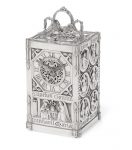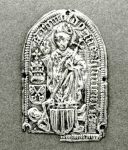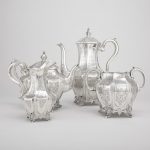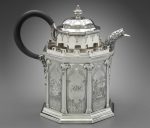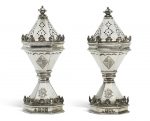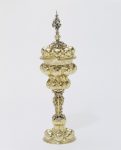Gothic Silver. The Gothic style first appeared in the 12th century in the area around Paris. In architecture, Gothic buildings employed a variety of new techniques to pierce walls with larger windows and to build loftier spaces. In sculpture and the other figurative arts, the style combined the detailed observation of nature with an expressive elegance. Gothic quickly spread throughout Europe, and versions of the style were still in use as late as the 1550s. Reference: The Victoria and Albert Museum
A Gothic revival style occurred during the Victorian era. The style also found it’s way into many silver and other precious metal items.
A good and unusual French silvered bronze Gothic Revival ‘Angelus’ carriage clock Lucien Falize, Paris circa 1878-1880 The cast case having a dial with Roman numerals and panels depicting figures representing months of the year and inscribed in Latin, the twin train movement with tandem wind, push repeat mechanism and lever platform escapement, striking on a gong, underside stamped ‘AXF’ within a lozenge and ‘Déposé’ height 7in (17.8cm)
Sold for US$ 7,500 (£ 5,772) inc. premium at Bonhams in 2018
Silver pilgrim badge of St. Rumold of Mechelen in the form of an arched gable. It is embossed with a figure of the sainted bishop,who wears a mitre and chasuble, holds a crozier and is giving a gesture of benediction. Under his feet is a heraldic shield, behind him is an assassin holding a hoe,and at his side is another shield bearing crossed keys, surmounted by papal tiara and cross. An inscription in gothic script runs between two outer borders.
Made in Belgium circa 14th,15th century
A VICTORIAN GOTHIC REVIVAL SILVER-GILT, GEM-SET AND ENAMEL-MOUNTED POTTERY FLASK DESIGNED BY WILLIAM BURGES, DATED 1868 The brown crackle glaze body elongated ovoid, painted in blue underneath with a dragon, within a silver-gilt wire support set with opal cabochons, each wire terminating in a cast root motif on a plain border with crenellated rim, the foot signed ‘WILLIAM. BURGES. ME. FE. MDCCCLXVIII’ on a blue enamel ground, the rim set with further opals and with a border depicting leopards within the initials W and B on a blue and green enamel ground and with applied foliage above, the hinged cover with pearl set spider finial, with internal stopper 6 1/4 in. (16 cm.) high
Sold for GBP 110,000 at Christies in 2016
Assembled Victorian Gothic Revival Silver Tea Service Joseph Angell & Joseph Angell, London, circa 1847-48 Comprising a teapot, coffee pot, cream jug and sugar bowl, the faceted body engraved with strapwork raised on mask and strapwork feet. Height of coffee pot 11 inches, total approximately 69 ounces. Generally in good condition overall; each piece engraved with Gothic script monogram; coffee pot handle slightly loose; teapot with slight rock; cream jug and sugar bowl with slight rock
Sold for $1,875 (includes buyer’s premium) at Doyle New York in 2015
A French Gothic revival partly gilt silver chalice, 950/000, maker’s mark J. P. (Pernolet), H 24 cm – Weight: about 279g
Sold for €1,200 at Carlo Bonte Auctions in 2018
Reliquary of the hand of St. Martha
This reliquary of the hand of Saint Martha is a monstrance, a vessel with a lunette of crystal or glass through which the holy relic (now lost) could originally be seen.. A German-born metalworker made this reliquary in Venice in the late fifteenth century, at the request of the nuns of the monastery of St. Martha. It is typical of the Gothic style then flourishing in Venice and attests to the part played by German metalworkers in spreading that style throughout Veneto. Ornate decoration typical of the late fifteenth century The six-lobed foot resting on four human heads is decorated with six medallions (four with the symbols of the Evangelists, and two with female saints carrying palm leaves, an attribute of the martyrs). The shaft is composed of twelve small figures of female saints. The knot has architectural niches featurng St. Margaret; a holy abbess with a falcon; a female figure bearing a crown and a chalice; another female figure that might represent the Church; an abbess holding a book and a crozier; and a Franciscan monk bearing a cross. Above the knot, God the Father seems to be supporting the upper part of the reliquary. In small, pinnacled niches on the right-hand slopes are St. Barbe and a female saint with pincers; on the left,-hand slopes are two crowned women, one holding a lance, the other a palm leaf. Three angels and a prophet are depicted on each side above the pinnacles. The reliquary is crowned by a canopy over a Pietà and surmounted by a depiction of God the Father. Brilliant metalwork combining low relief, rond-bosse, chasing, filigree, and milling serves the religious iconography well. Abundant ornamentation is a common feature of late fifteenth-century Italian precious metalwork.
Reference:The Louvre
A splendid showcase of multiple materials and techniques, this miniature triptych was designed to inspire the private devotions of its owner (perhaps one of the Cardinals Madruzzo, successive Prince-Bishops of Trent). With precious metal tracery applied to expensive ebony, its hinged wooden doors invite handling. They lead not into a tiny Gothic chapel but onto an illusionistic nighttime landscape, busy with worshippers adoring the Christ Child. Both artists signed this glorious collaboration; Walbaum, as one of wealthy Augsburg’s most renowned goldsmiths, would probably have been the more vaunted of the two. Walbaum and Mozart worked together on at least one other, strikingly similar, miniature triptych.
Marking: [1] flower within a shield (maker’s mark of Matthias Walbaum); [2] pinecone (Augsburg town mark)Reference: The Metropolitan Museum of Art
Silver goblet featuring reproduction from Panthenon Frieze Made 1887 This silver goblet is decorated with classical-style horses and riders inspired by those from the north frieze of the Parthenon in Athens. Sir James Martin (1820-86), whose crest is engraved on one side, favoured the Grecian style over the rival neo-Gothic style. Martin’s advocacy of the classical extended to his famous garden at his house, Clarens, in Sydney’s Potts Point. Here, Martin had a sandstone replica erected of the choragic monument of Lysicrates (built 335 BC Athens) which with subdivision of the property was re-sited to Sydney’s Royal Botanic Garden where it still stands.
Reference: Museum of Applied Art and Sciences
Teapot about 1835–52 Made by John C. Moore (American, about 1803–1878), Retailed by J. and I. Cox (American, partnership active 1817/18–1852)
Straight-sided octagonal form on molded base, each corner applied with an engaged Ionic column framing panels flat-chased with similar columns and Gothic arches. Four panels are finely flat-chased with landscapes, on including a bridge, one a farmhouse, and two with castles above water, one the two vacant panels is engraved with scrip initials “SEH”. Above the molded upper rim is a crenellated battlement surrounding the octagonal neck further flat-chased with Gothic arches. The side-hinged and domed cover is similarly flat-chased and has a silver finial. The spout and the sockets for the wooden loop handle are cast in naturalistic bark style. Inscription “SEH” script initials on one side panel Markings Marked on the bottom “J & I Cox”, “M” between a star and an anchor (now identified as the mark of John C. Moore), and “N.Y.”
Reference: Museum of Fine Arts Boston
R & S Garrard, London, active 1835-1909 GOTHIC REVIVAL PEPPERS modelled as 15th century standing salts; hexagonal panelled form, apllied with the Salters’ Company shield and VR 1837-1897 for Queen Victoria’s Diamond Jubilee, additionally engraved with a coat-of arms and cypher, in a later fitted Wartski case hallmarked London, 1897 silver height: 12.2cm., 4 3/4 in.; 374gr., 12oz.
Sold for 1,063 GBP at Sothebys in 2018
Covered cup decorated with late Gothic lobes
Michael Müllner was a highly successful Nuremberg master. Together with others such as Hans Petzold, he played a leading role in the revival of the Gothic style in the early 17th century. Although the swirling lobes are typical of the 15th-century Gothic style, the date of the cup is betrayed by the etched ornament around the lip. The cover of this cup is a little too wide for the cup; it is possible that there was originally a pair of cups and that the covers were accidentally switched.
Reference: © Victoria and Albert Museum
